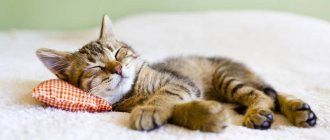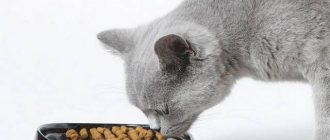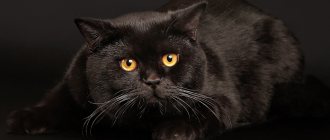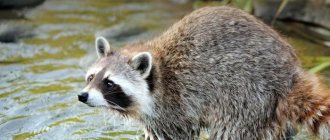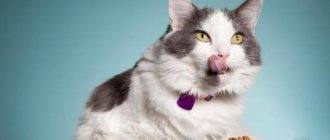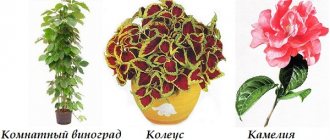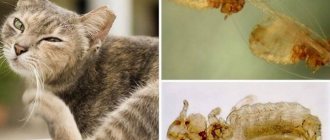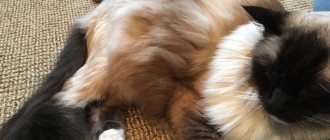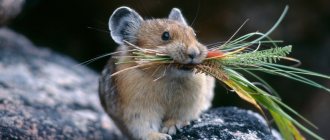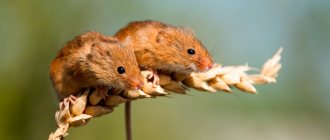What is better - buying or cooking?
Experts believe that everything depends on the capabilities of the owner and the preferences of the pet.
Both options have their pros and cons. Industrial feed is convenient - just open the package and measure out the desired portion. But it is difficult to fully understand their composition - it is not always indicated on the packaging, and it is simply impossible to check the quality of the ingredients.
You can choose products for natural nutrition yourself, but this requires the skills of both a nutritionist and a cook.
Pavel Klimov veterinarian
5,0 131
Open profile
Natural food is better than industrial food if three conditions are met: the diet is balanced, the quality of the products is high and there is time to prepare food for the animal.
How to keep meat safe
Bacteria, parasites, and viruses die at high and low temperatures; to reduce the risk of infection, the following methods are used:
- Freezing . In home refrigerators, at minus 18℃, parasites die in 4 days. This does not apply to trichinella and salmonella; frost does not affect them.
- Cooking . In boiling water, viruses and bacteria die within 1 – 20 minutes; it will take 3 hours to destroy Trichinella.
When scalded with boiling water, bacteria are destroyed from the surface; this method will not protect against helminthiasis. Meat is not kept next to other food; a separate knife and cutting board are allocated for it.
Types of cat food
Industrial feeds are divided into three types:
- dry,
- semi-dry,
- wet.
| Dry (6-10% moisture) | Semi-dry (35% moisture) | Wet (75% moisture) | |
| Compound | Meat, fish, poultry or organ meats, grains, vitamins and mineral supplements | Meat, fish, poultry or by-products, grains, vitamins and mineral supplements, preservatives | Meat, fish, poultry or by-products, grains, vitamins and mineral supplements, preservatives |
| pros | The best ratio of price and feed consumption. Prevents the formation of dental plaque. It can be stored for a long time. | Smells and tastes attractive to cats. Suitable for cats that cannot eat dry food. | Provides the cat's need for water. Suitable for sick and elderly animals. The most delicious food, liked by most cats. |
| Minuses | Weak smell and taste. You need to make sure your cat always has water. | Costs more than dry. Contains more sugar than other types of food. If opened, it dries out or deteriorates quickly. | High price. It deteriorates quickly when opened. |
Dry and semi-dry food
It’s most convenient for owners who feed their pets on a flexible schedule: if you pour dry food into a bowl in the morning, it will remain fresh and tasty until the evening. This is also a suitable option for cases when you need to go away for 1-2 days and leave the cat alone. The main disadvantage of dry food is that it contains virtually no moisture, so the animal should always have fresh water in a bowl, water bottle or drinking fountain.
In July, Roskachestvo published a rating of 39 feeds from well-known manufacturers. The top 5 brands included:
- Orijen
- Nutram
- Pronature
- Now Fresh
- Acana
Dry and semi-dry food should be stored in a hermetically sealed bag, monitor the expiration date and not buy in bulk - it is unknown how long they have been left open.
Wet food
Suitable for sick and convalescent cats, as well as old animals that find it difficult to chew dry pellets. This food contains enough liquid, so cats drink very little.
The main disadvantage is that spiders and canned food spoil quickly. If the cat does not eat the portion immediately, after half an hour the product will dry out and dry out in the evening. Therefore, the leftover food is thrown away, and the printed packaging is stored in the refrigerator, tightly closed, for no more than 2-3 days.
Another disadvantage of wet food is that it does not prevent the formation of plaque. Therefore, if your cat eats canned food, then she needs to brush her teeth periodically.
Careful, treats!
When choosing wet food, be sure to check that it is suitable for daily feeding. Sometimes owners confuse it with a treat. For example, it could be pouches or gourmet canned food. And although they look the same, this is just a “dessert” and not a full meal.
Treats are needed to restore interest in food in a sick or picky cat, or to pamper an animal if it is stressed from moving, having a new pet, or changing owners.
Is it possible to mix?
Experts believe that it is acceptable to give your cat both dry food and canned food at once. But it is important to consider two points:
- do not mix different types of food in one bowl;
- choose food from one manufacturer.
Products from different companies are mixed just to switch a cat from one type to another.
Daria Tarasova veterinarian
5,0 99
Open profile
Dry and wet industrial food can be given together if it is the same brand and line - they differ only in the amount of water in the composition. It is important that both foods contain the same type of protein - for example, you should not give dry food with fish, or wet food with turkey.
Feed classes
Industrial cat food is divided into three classes:
- Economy
- Premium and superpremium
- Holistic
The classification is based on the quantity and quality of products. The price also depends on the class.
Economy class
At first glance, this is the most budget option. But these foods can cause health problems for animals due to their low protein content, high amounts of soy, artificial colors and oxidizing agents. Sometimes they may even consist of bran alone. Cheap food is similar to fast food for people and is useful in much the same way as instant soups.
Daria Tarasova veterinarian
5,0 99
Open profile
As a dermatologist, I very often encounter unwanted food reactions - itching, irritation and hair loss - to economy class spiders. These foods contain insufficient quantity and quality of protein to keep your cat healthy, as well as questionable quality ingredients. In addition, many flavoring additives are added to make the food more appetizing to the animal.
It turns out that the low price of economy food is deceptive - after all, such food will most likely require the owner to spend money on a veterinarian and medications. In addition, supposedly budget wet food is actually more expensive than premium dry food.
Pavel Klimov veterinarian
5,0 131
Open profile
Let's look at the example of a hypothetical three-kilogram sterilized cat and premium food. The cost of a package weighing 2 kg is approximately 1000 rubles, the daily requirement of a cat is about 50 g. It turns out that such a package will last for 40 days, 25 rubles per day. A bag of economy class food costs an average of 20 rubles. And this is only for one feeding, and there are two or three of them a day - a total of 40-60 rubles. It turns out that the dry premium diet is almost 2 times cheaper than the wet economy diet.
Premium class
According to experts, this is the best ready-made food option that suits most animals. Nutritionists work on the composition, monitoring not only the quality of the products, but also the method of their preparation. For example, cheap canned food has few nutrients - they are partially destroyed during heat treatment. In expensive feeds, the possibility of such losses is taken into account in advance.
Holistic and medicinal foods
Separately, there are “holistic” or Human Grade foods. All of their ingredients are suitable for human use. It contains a lot of protein - fresh meat, easily digestible carbohydrates - potatoes, peas, lentils, fiber - vegetables, fruits, berries. And also natural preservatives and high-quality vitamin and mineral supplements.
Veterinarian Tatyana Khleborad notes that such food is suitable for animals that have an additional burden - for example, they are free-range, pregnant or sterilized.
But if your pet has kidney or liver problems, this diet may worsen the disease. In this case, you need to select products from the medicinal line, which is available from all major manufacturers. They are formulated taking into account the special needs of the animal, but at the same time they do not differ much in taste from regular food - so it is easy to accustom the cat to them.
Why is excess weight dangerous?
Some owners want their pet to be fat.
It is believed that a chubby cat is a happy cat. Perhaps this is why most domestic cats are obese, and their owners do not see anything wrong with it. Excess weight causes many inconveniences. The cat becomes inactive, it is difficult for him to jump even on low surfaces. Your pet's hormonal levels change. An overgrown fat layer increases the load on joints and ligaments. An obese cat increases the risk of developing diabetes.
Have your cat weighed by a veterinarian periodically and take action if your pet is overweight. If you know that the cat is “bottomless” and likes to have a hearty lunch, strictly control the volume of portions in accordance with normal weight. Play with your pet, take it out to the country to increase physical activity.
Photo source: pixabay.com/ru/
How to read labels: what should be in the food
Ingredients are usually listed by weight on the label. For example, in wet food, beef, fish, chicken and turkey will be at the top of the list, but in dry food they may be at the very end due to the excess moisture being removed from them. Experts warn that the packaging may not contain complete information. If in doubt, it is better to consult a doctor or go to the manufacturer’s website and contact support.
How to read the label:
First step
- look at the name and compare with the composition. It should consist of 35–95%, not counting water, of the product stated in the name. For example, if it is rabbit food, then the main ingredient should be rabbit meat.
Second step
— check the entire list of components.
Cats are descendants of semi-desert carnivores, so they need a lot of protein, a moderate amount of fat and a minimum of carbohydrates. And also vitamins, minerals, fatty acids and amino acids. Therefore, check that the composition contains animal protein - cats need taurine and Omega-6 arachidonic acid, which are found only in animal and poultry meat or offal. These elements cannot be obtained from plant foods, so vegetarianism is contraindicated for cats.
Useful and harmful components in cat food
Useful
- Protein - beef, chicken, turkey, rabbit - at least 35%.
- Fiber - oats, wheat, rice, and carbohydrates - no more than 25%, otherwise the cat may have an upset stomach.
- By-products - at least 30% of the composition.
- Vitamins and mineral supplements: taurine, Omega-6 arachidonic acid, calcium, vitamin A, E, K, B vitamins, ascorbic acid, zinc, copper, amino acids. Vitamin D is essential for kittens.
Harmful
- Dye E127 can provoke cancer.
- Oxidizing agents E320 and E321 can damage the liver, cause seizures and neuroses.
- Waste - skin, cartilage, feathers, horns, beaks, hooves. If a specific protein source is not indicated on the packaging, the manufacturer may be hiding the fact that the food is made from waste.
Veterinarian Ivan Ryzhov notes that food containing chicken should be given to pets with caution. This is a strong allergen, the effect of which does not appear immediately. Therefore, if your cat has itching or dull fur, check the composition and consult a doctor.
Are by-products healthy?
Many owners avoid them because I think that waste - horns, hooves, skin, beaks - also falls into this category. But by-products are internal organs, such as liver, kidneys, lungs, heart. They are healthy, nutritious and easily digestible by the cat's body. The food packaging must list the specific by-products that it contains.
What meat should you not feed your cat?
The following products are prohibited:
- Fresh steam . Unprocessed meat is a potential source of harmful bacteria, helminth larvae and eggs.
- Salty . Salt disrupts the balance of minerals and retains fluid.
- Fried . Excess oil upsets metabolism.
- Canned . To increase shelf life, components harmful to cats are included: salt, seasonings, spices.
- Smoked . Wood smoke contains volatile carcinogens. When smoking for industrial purposes, meat is doused with an artificial liquid, which corrodes the gastric mucosa and causes an allergic reaction.
- Dried . The product is kept in a marinade with additives harmful to animals: salt, vinegar, spices, garlic.
- Meat waste . Bones, paws, and heads injure the digestive organs; cats do not digest chicken and turkey skin. The trimmings are taken from the surface of the piece, and therefore contain pathogenic microbes.
- Pieces larger than 2 cm . Large chunks are difficult to chew, making nutrients less absorbable.
- Meat puree . A cat's teeth need stress; if you constantly feed them soft food, they are destroyed. The puree is suitable for kittens or adult animals with digestive tract problems.
The table lists the varieties that should not be given to your pet:
| View | Harm to the cat |
| Pork | A protein to fat ratio of 14:33 is not good for a cat. Contains histamines. Possible source of parasites. |
| Goose | The muscle tissue of birds older than six months becomes tough and difficult to digest. Fat content reaches 38%, calorie content 369 kcal. |
| Mutton | Difficult to digest, high fat content. |
| Duck | In terms of calories and fat, it is comparable to goose. |
| Fresh liver | Poorly absorbed, causes diarrhea. |
| Raw chicken | There is a risk of salmonellosis infection. |
| Pork by-products | They have the same negative qualities as meat. |
| Raw lung | Not digestible, poor composition of nutrients. |
| Store-bought minced meat | Contains fat, skin. |
| Necks of domestic chickens | The vertebrae are too hard for cats. |
Kefir in feeding cats
Is it possible to give a cat smecta?
Fish oil in the diet of cats
A one-time inclusion of fatty meat in your diet will not harm. With constant feeding, the animal develops problems. First, weight increases, and against the background of obesity, cardiovascular diseases and diabetes develop.
Natural food: we create the menu ourselves
For those who decide to feed their cat natural food, there are several important recommendations.
- Do not try to repeat the menu from the wild - you do not need to get rodents and birds for your pet.
- You should not feed raw meat - it may contain parasites. The meat should be scalded with hot water or placed in the freezer for three days.
- Do not feed the animal from your table - most human food is contraindicated for cats. You need to either prepare special food for your pet or order properly frozen mixtures of natural products from pet stores on the Internet.
Natural foods: what you can and cannot give to cats
| Can | It is forbidden |
| Beef, veal, turkey, rabbit, chicken, offal | Pork and lamb, chicken and any boiled bones |
| Ocean or boiled river fish - 1-2 times a week | Raw river fish |
| Fresh cucumbers, zucchini, carrots, beets, white cabbage | Potatoes, onions and garlic, tomatoes, exotic fruits, mushrooms |
| Dairy products | Milk and dairy products |
| Sprouted oats, wheat or corn, barley porridge | Nuts, seeds and dried fruits |
| Boiled eggs - 1-2 times a week | Bread, pastries, pasta |
| Sweets: chocolate, ice cream, condensed milk, chewing gum Salt and pickles, spices Coffee, cocoa, alcohol | |
| Dog food and cat food not suitable for age group |
Tatyana Khleborad veterinarian
4,94 50
Open profile
Natural nutrition does not imply pure meat - it must contain vegetables, vitamins and microelements. Therefore, “natural food” should be considered by those who have free time, as well as the desire and skills to prepare separate food for their pet and monitor the balance of the diet.
What's wrong with fish and milk?
Cats eat fish and milk in books and cartoons. In real life, milk and dairy products cause diarrhea in most pets. Animals, like people, lose the ability to digest milk with age - the body gradually stops producing enzymes that break down lactose.
When it comes to fish, cat owners are divided into two camps. Opponents believe that raw fish provokes the development of urolithiasis. However, veterinarian Ksenia Kamenskaya notes that she has not come across scientific studies that would confirm this fact.
But there is still a real threat - intestinal parasites. Scalding and freezing fish does not always completely destroy worms. Therefore, if you want to feed your animal fish 1-2 times a week, you should boil it or give your cat anthelmintic drugs once every three months.
Is it possible to mix industrial and natural food?
Veterinarians recommend choosing one type of feeding and sticking to it. If you give your cat premium food, an additional piece of natural meat will upset the balance of the diet. Therefore, you should not mix.
But you can offer your pet vegetables in addition to canned food. In addition, if part of the animal protein is replaced with vegetable protein in the finished food, a little chicken breast or beef will not hurt.
Why is fish bad for cats?
- A blow to the kidneys. The salts found in fish “sit down” this important organ.
- Provocation of urolithiasis. Phosphorus and magnesium contained in fish are building materials for struvite urinary stones.
- Source of helminthic infestation. Particularly unpleasant is opisthorchiasis - a long-term, constantly worsening helminthiasis that affects the liver, gall bladder and pancreas. Its source is carp fish.
- Hypovitaminosis. The enzyme thiaminase, present in some types of fish, destroys vitamin B1 (thiamine), trimethylamine oxide binds iron, making it indigestible, the result is anemia. Long-term consumption of fish also depletes vitamin E resources.
- Vitamin K is necessary for proper blood clotting. Cats can synthesize their own vitamin K from most foods, but a fish-based diet does not support the synthesis of this vitamin in sufficient quantities.
- Seafood in general is a rich source of iodine, but cats cannot absorb much of it. There is a connection between a cat's consumption of iodine-rich food and the development of hyperthyroidism (increased thyroid function).
- Presence of bones. Fish bones are one of the causes of injury to the larynx, esophagus, and intestines of a cat(!)
- Development of allergies. Fish, or rather its protein, is one of the most allergenic foods for cats. And allergies are serious!
- Ecology. Fish is far from a safe product. It is no secret that modern reservoirs contain elements of the periodic table that are unusual for them, which “settle” in the body of their inhabitants. Fish, especially predatory species, may contain elevated levels of heavy metals (including mercury), pesticides and other toxins. This fish is not good for people either, but cats are at even greater risk! In addition, now some types of fish (in particular salmon, trout) are grown in special incubators, where they use chemical additives, antibiotics, etc.
- Aesthetic moment. The fact that a cat eats fish can be unmistakably determined by the smell from its tray (the laurels of primacy here go to pollock)
How to tell if food is right for your cat
Veterinarian Daria Tarasova explains that the food is balanced and suitable for your pet if he has:
- shiny, smooth coat - no itching, irritation, or unpleasant odor;
- no discharge from the eyes;
- normal physique - no exhaustion or obesity;
- formed feces once a day, in an amount less than the incoming food;
- normal activity.
Owners often try to diversify their cats' diet and invite them to try something new. But animals don't need a new menu every day. The most important thing for them is the feeding regime and the quality of food. Therefore, you need to switch your pet from one food to another only when you are not satisfied with something in its condition or behavior.
The transition from one manufacturer to another takes about 3-5 days - for this you need to gradually mix more and more new food into the old food. Changing the type of feeding - from wet to dry or from industrial to natural - will require 10 days or more.
